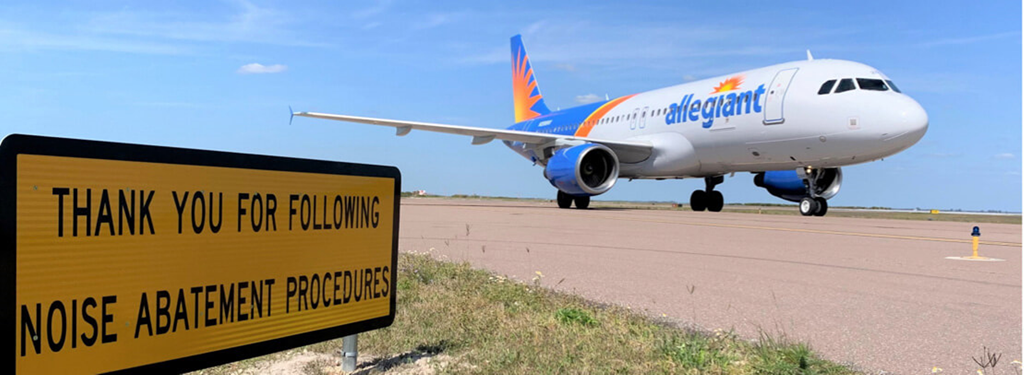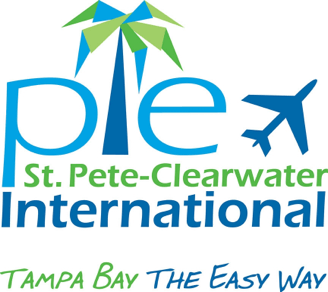
Noise Affairs
Welcome to Noise Affairs. St. Pete-Clearwater International (PIE) is committed to educate and minimize the effects and exposure of aircraft noise to the extent possible within the guidelines of the Federal Aviation Administration.
To file a Noise Complaint, click https://fs30.formsite.com/Pinellas8/psdvxhderj/index
For additional information concerning noise affairs, contact the Noise Affairs Office at (727) 453-7877 or airportnoise@fly2pie.com.
The Federal Aviation Administration (FAA) Metroplex initiatives are improving traffic flow and reducing congestion in major metropolitan areas across the country. FAA information and the Final Environmental Assessment (EA) is on the Florida Metroplex Environmental website at http://metroplexenvironmental.com/fl_metroplex/fl_docs.html.
Track flights at PIE
St. Pete-Clearwater International suggests using the following free Flight Tracking System that allows you to independently watch the movement of flights and air traffic patterns within the Tampa Bay region.
Flight Radar 24: https://www.flightradar24.com/27.88,-82.80/6
Flight View: https://www.flightview.com/
Flight Aware: Clearwater Intl Airport Overview and FBOs (St Petersburg-Clearwater, FL) [KPIE/PIE] - FlightAware
National Airspace System Status: https://nasstatus.faa.gov/map
If you can’t find a particular flight, you can e-mail or call with the date, time, address or approximate location of the flight, and a representative will respond back with the information you requested within 24 hours.
Noise Abatement Working Group (NAWG)
The Noise Abatement Working Group is made up of representatives from government officials, a mix of aviation industry representatives, and local citizens. The goals are to educate the community on traffic patterns, flight routes and arrival /departure procedures, and to explore methods of reducing aircraft noise and impacts on residential neighborhoods surrounding the airport.
Noise reports are posted quarterly, and meetings are held semi-annually with reports submitted to the Board of County Commissioners. Current reports, along with the minutes taken at meetings this past year, are available for review below.
For questions about the NAWG or for information on how to contact your local representative, please call or email the Noise Affairs Office at (727) 453-7877, airportnoise@fly2pie.com.
NAWG Meetings
All meetings are open to the public.
2025 Schedule:
Time: 3:00 p.m.
- Wednesday, January 29, 2025
Place:
St. Pete-Clearwater Int'l Airport, Airport Conference Room #234,
14700 Terminal Blvd., Clearwater
NAWG Minutes
To view meeting minutes or noise reports, select the date of the meeting or quarterly reports you wish to view. For meeting minutes from earlier years, Please contact airportnoise@fly2pie.com. Minutes will be provided at no charge.
Adobe Acrobat Reader is required.
Q3 Noise Data
July 17, 2024
April 17, 2024
January 17, 2024
NAWG Semi-Annual Reports
To view the semi-annual reports, select the date of the report you wish to view. For reports from earlier years, Please contact airportnoise@fly2pie.com. Reports will be provided at no charge.
Adobe Acrobat Reader is required.
April & July 2024
Oct 2023 & Jan 2024
Noise Abatement Procedures
Arrival Procedures
Runway 18/36 – when in use and weather permits, aircraft arriving are strongly encouraged to utilize the established noise abatement procedures.
Voluntary Quiet Hours
To the extent practical, the airport requests air carriers avoid scheduling flights during the Airport's "Voluntary Quiet Window" between the hours of 11:00 p.m. and 6:00 a.m. local time daily.
The following operations are strongly discouraged between the hours of 11:00 p.m. – 6:00 a.m. local time daily, unless otherwise pre-approved by the Airport Director or his representative:
- “Touch-and-go” takeoffs and landings
- Practice instrument approaches
-
Engine ground run-ups for routine maintenance purposes
General Aviation
FAQ
Aircraft cannot descend at too steep an angle as they approach an airport. The standard is a three-degree angle of descent, referred to as the “glide slope.” Aircraft will usually remain as high as the glide slope standard will allow until touchdown.
The Airport has the ability to check most aircraft altitudes on a case-by-case basis to confirm whether an aircraft is complying with this measure. However, compliance with this measure, is voluntary, and the flight path of each flight is ultimately determined by the FAA Air Traffic Control Tower and the aircraft’s pilot.
No. The sound levels around the airport are lower on average than in the past. One reason is that aircraft engines are quieter. Over the years, the FAA has imposed progressively lower limits on the noise that civilian aircraft make. The FAA’s imposition of progressively more demanding standards has resulted in a major reduction in the noise generated by modern aircraft.
Can aircraft fly over my house? Yes.
Can aircraft overfly densely populated areas? Yes.
Can aircraft at PIE operate at night or in the early morning hours? Yes.
Can the Airport Noise Affairs office restrict where aircraft fly and when? No.
Can the airport restrict certain aircraft that operate at PIE? No.
Can the airport turn down a carrier that wishes to operate at PIE? No.
Can the airport dictate aircraft arrival or departure times? No.
Can aircraft deviate from noise abatement procedures? Yes.
Can PIE airport fine an airline for not complying with the noise abatement procedures? No.
Can loud military jets fly in and out of PIE at any time? Yes
St. Pete-Clearwater International Airport understands that aircraft noise can have an effect on our surrounding communities. Every complaint we receive is:
- Analyzed
- Registered
- Responded to upon request
We analyze complaints by comparing the date and time of the complaint with our Flight Tracking System records, in order to determine what may have caused the issue and how St. Pete- Clearwater International Airport can learn from this occurrence.
St. Pete-Clearwater International Airport strives to be a good neighbor. Our main goal is to minimize the number of people who are living with aircraft noise on a daily basis.
If you are considering buying a home near St. Pete-Clearwater International Airport, the Noise Affairs Office can provide up-to-date information about flight paths for areas in and around the Airport. We can help you understand what to expect when living near a busy airport. If you are buying a home, please check your real estate disclosure packet or ask your real estate agent to see if the property is located near a flight path.
Not everyone is affected by noise in the same way. Take this short survey to better understand how aircraft noise could affect you. Some things to consider are:
- Are you sensitive to noise?
- Are you a light sleeper or do you wake up often?
- Is the home in a relatively quiet area, away from major traffic and other noises that could potentially mask aircraft noise?
- Is the home close to the Airport or directly below regular aircraft flight paths?
- Is the home poorly insulated from noise?
- Are you usually at home during the day?
- Do you regularly entertain outside?
- Do you usually sleep with the bedroom windows open?
If you answered yes to a number of these questions, then you are more likely to be disrupted by aircraft noise.
We take the concerns of all community members affected by our operations seriously. We take a balanced approached when assessing any noise mitigation initiatives. The complaints help us understand what impacts our airport operations are having on the community and help us:
- determine where to focus our community outreach, (i.e., education)
- check that Noise Abatement Procedures are being followed
- identify trends or irregularities that may need to be investigated or assessed
- communicate with the community about our operations, provide accurate information (address myths/rumors or inaccurate information)
- inform elected officials about community concerns; and
- assess future impacts of our growth.
The Federal Aviation Administration (FAA) is the sole organization in the United States responsible for the movement of aircraft both on the ground and in the air. The FAA is also responsible for designing air travel routes and procedures, including the standards for lateral and vertical separation between aircraft and determining hazards to flight such as mountains or tall buildings. An airport may advocate for certain noise abatement flight tracks to reduce noise, but these must be both approved and assigned by the FAA.
Here are some helpful FAA website links:
- FAA History of Noise
https://www.faa.gov/regulations_policies/policy_guidance/noise/history/ - Fundamentals of Noise and Sound
https://www.faa.gov/regulations_policies/policy_guidance/noise/basics/ - Noise Complaints and Inquiries
https://www.faa.gov/noise/inquiries/ - Flight Standards District Office (FSDO)
https://www.faa.gov/about/office_org/field_offices/fsdo/
The noise you hear at any particular time is largely determined by the direction that aircraft flies as they arrive at or depart from the Airport runways. Aircraft operations late at night and early in the morning generally take place over areas North or South of the Airport. However, several factors may alter the normal pattern, such as wind speed, direction, weather conditions and pilot or Air Traffic Controller choice.
The need to close runways or taxiways for maintenance and repairs may also change flight operations, resulting in flight patterns that residents are not accustomed to.
You may hear unaccustomed noise on certain days due to wind and other weather conditions, such as cloud cover and temperature inversions, that influence the way that sound travels.
In addition to these factors, there is an obvious difference in the volume of noise generated by different aircraft.
Because of these variables, the noise that you hear can vary from day to day and during the course of a day.
Noise Complaint Information
All information provided will be used solely in the investigation and documentation of the noise event and in the development of new noise abatement and mitigation measures.
Reports are investigated by Airport Operations personnel. A response may be requested via email or telephone. In most cases, a response will be provided within five (5) business days of complaint submission. Please report only one event per submission. If you are reporting multiple events, please submit a separate form for each event.
Please note: All noise complaint submissions become public record and subject to the Public Records Law of Florida.
Did you receive STAR Customer Service at St. Pete-Clearwater International Airport (PIE)?
How was your airport experience? We want your feedback! Did you receive STAR customer service? Click here to Share Your Story. Thank you for visiting PIE!


